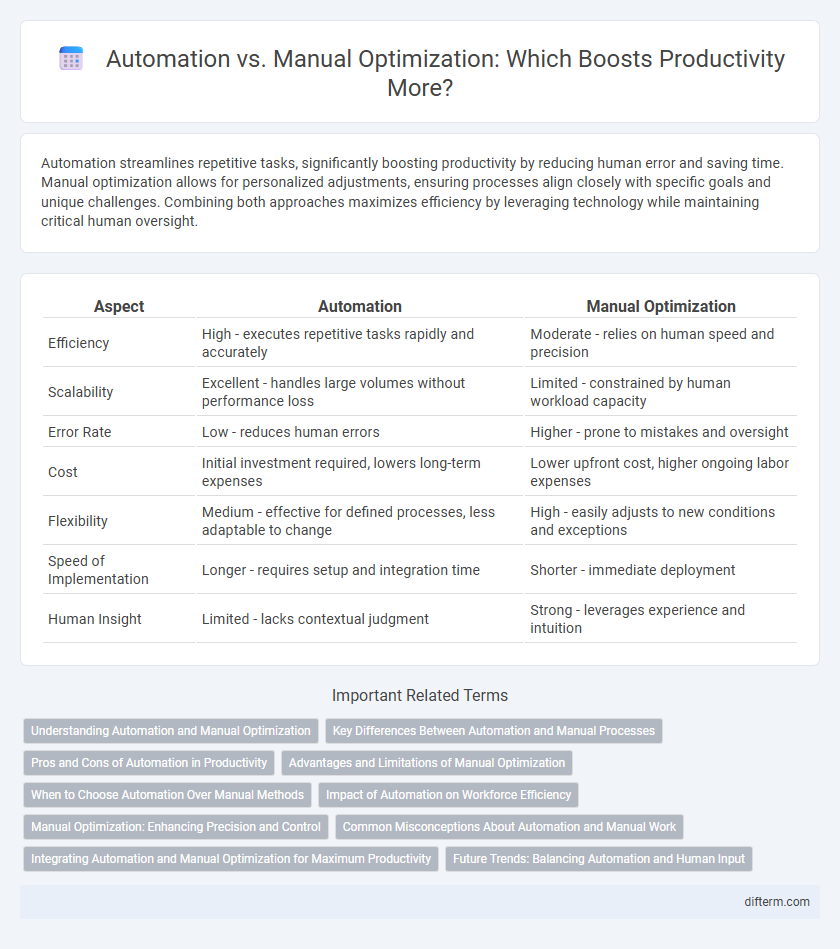Automation streamlines repetitive tasks, significantly boosting productivity by reducing human error and saving time. Manual optimization allows for personalized adjustments, ensuring processes align closely with specific goals and unique challenges. Combining both approaches maximizes efficiency by leveraging technology while maintaining critical human oversight.
Table of Comparison
| Aspect | Automation | Manual Optimization |
|---|---|---|
| Efficiency | High - executes repetitive tasks rapidly and accurately | Moderate - relies on human speed and precision |
| Scalability | Excellent - handles large volumes without performance loss | Limited - constrained by human workload capacity |
| Error Rate | Low - reduces human errors | Higher - prone to mistakes and oversight |
| Cost | Initial investment required, lowers long-term expenses | Lower upfront cost, higher ongoing labor expenses |
| Flexibility | Medium - effective for defined processes, less adaptable to change | High - easily adjusts to new conditions and exceptions |
| Speed of Implementation | Longer - requires setup and integration time | Shorter - immediate deployment |
| Human Insight | Limited - lacks contextual judgment | Strong - leverages experience and intuition |
Understanding Automation and Manual Optimization
Automation leverages technology to perform repetitive tasks with speed and accuracy, reducing human error and freeing up time for higher-value activities. Manual optimization relies on human judgment and expertise to fine-tune processes, allowing for customized adjustments that technology may overlook. Understanding the balance between automation and manual optimization is crucial for maximizing productivity by integrating efficiency with strategic insight.
Key Differences Between Automation and Manual Processes
Automation leverages software and technology to perform repetitive tasks with high speed, consistency, and minimal human intervention, significantly reducing errors compared to manual processes. Manual optimization relies on human judgment and expertise to adjust workflows, often allowing flexibility but increasing time consumption and potential for inconsistency. Key differences include scalability, where automation excels in handling large volumes, and adaptability, where manual processes provide nuanced customization in complex scenarios.
Pros and Cons of Automation in Productivity
Automation in productivity significantly reduces human error and accelerates task completion by handling repetitive processes with precision. However, reliance on automation can lead to high initial setup costs and decreased flexibility when adapting to unique or complex tasks. Balancing automation with manual oversight ensures efficiency while maintaining creative problem-solving capabilities.
Advantages and Limitations of Manual Optimization
Manual optimization offers precise control and customization tailored to unique business processes, enabling nuanced decision-making based on human expertise. It allows for flexibility in handling exceptions and adapting to unforeseen changes, which automated systems may struggle to accommodate. However, manual optimization is time-consuming, prone to human error, and less scalable compared to automation, limiting efficiency in handling large-scale or repetitive tasks.
When to Choose Automation Over Manual Methods
Choose automation over manual methods when repetitive tasks consume significant time and resources, boosting efficiency and accuracy. Automation is ideal for processes requiring consistency across large data sets, reducing human error and operational costs. Manual optimization suits unique, complex tasks demanding human intuition, but automation excels in scaling productivity and minimizing delays.
Impact of Automation on Workforce Efficiency
Automation significantly enhances workforce efficiency by streamlining repetitive tasks, reducing human error, and accelerating production timelines. Integrating automated systems allows employees to focus on higher-value activities, boosting productivity and innovation. Companies adopting automation report up to a 40% increase in operational efficiency and a notable decrease in labor costs.
Manual Optimization: Enhancing Precision and Control
Manual optimization enhances productivity by allowing for precise adjustments tailored to specific tasks, ensuring greater accuracy than automated processes. This approach grants users full control over workflows, enabling the identification and correction of nuanced inefficiencies that automation may overlook. By focusing on manual refinement, businesses can achieve higher quality outcomes and customized performance improvements.
Common Misconceptions About Automation and Manual Work
Automation is often misunderstood as a complete replacement for manual work, yet it is best viewed as a tool to enhance efficiency by handling repetitive tasks, freeing human workers to focus on strategic decision-making. Manual optimization is mistakenly perceived as outdated, but it remains critical for tasks requiring complex judgment, creativity, and adaptability. Both automation and manual processes complement each other to maximize productivity rather than serving as mutually exclusive solutions.
Integrating Automation and Manual Optimization for Maximum Productivity
Integrating automation and manual optimization enhances productivity by combining the precision and efficiency of automated systems with the adaptability and critical thinking of human input. Automation streamlines repetitive tasks, reducing errors and saving time, while manual optimization fine-tunes processes based on real-time insights and contextual understanding. Leveraging both approaches creates a dynamic workflow that maximizes output quality and operational efficiency.
Future Trends: Balancing Automation and Human Input
Future productivity trends emphasize a strategic balance between automation and human input, leveraging AI-driven tools to enhance efficiency while preserving critical human creativity and decision-making. Advanced machine learning algorithms optimize repetitive tasks, freeing human resources for complex problem-solving and innovation. Organizations adopting a hybrid approach with adaptive automation systems report higher performance metrics and sustainable growth in dynamic market environments.
Automation vs Manual Optimization Infographic

 difterm.com
difterm.com